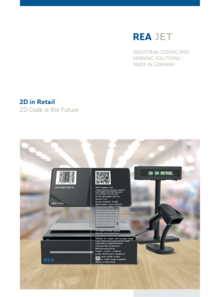2D checkout code with GS1 Digital Link
Standardized barcodes such as EAN-13 or UPC-A have revolutionized logistics and retail. Now a new revolution is on the horizon. Companies around the world are modernizing their packaging and product marking and improving the entire information flow by printing 2D Codes.

Until now, EAN-13 barcodes have been used as checkout codes in retail and logistics. However, due to their very limited data capacity and growing connectivity, they are simply no longer up to date. Manufacturers are increasingly expected to provide product information in a simple and accessible way. Be it for consumers who want to know more about a specific product or for wholesalers and retailers who want to optimize their efficiency by having access to accurate product data and supply chain information.
A standardized solution for digital product marking developed by the GS1 organization combines existing GS1 standards with a new universal code - the GS1 Digital Link. With the new GS1 Digital Link standard, GS1 identifiers - such as the GTIN - are linked to the Internet. With this new standard, different information about a product can be made available flexibly via a single link. This means that the information can be adapted at any time without having to renew the data carrier, such as the QR code, and its content.
Existing GS1 identifiers, such as the GTIN, remain valid and are embedded in a standard-compliant URL of the brand owner.
Since 2021, the GS1 2D DataMatrix, the QR code with GS1 Digital Link and the DataMatrix code with GS1 Digital Link have been approved as checkout codes at the point of sale. Migration to GS1 Digital Link can be carried out without major changes to existing systems and processes. The aim is to achieve a worldwide migration to 2D cash register codes by 2027.

The GS1 Digital Link can be used with any type of 2D Code - but typically with a QR code. Consumers can then use their smartphone to scan the QR code on the product packaging, which redirects them to a defined website. Depending on the user, different information can be displayed in different languages and formats. This is because conceptually it is one and the same 2D checkout code that is accessed. But different apps lead users to completely different destinations. For example, one app provides consumers with extended product information such as origin, ingredients or the best before date (BBD). With other apps, it is again possible to promote customer loyalty through interactions with the app, raffles or discount campaigns. And for the manufacturer, the very same code can provide information for process control, such as inventory management, traceability, production planning and targeted recalls.

The structure
What does a QR code with GS1 Digital Link look like?
To summarize briefly: The GS1 Digital Link puts GS1 ID's into a web-friendly format that can typically be coded into a QR code.
In this example, several data contents are linked in a GS1 Digital Link and coded in a QR code. The information embedded here is the GTIN 04270001108739, the batch number Lot1, the serial number 12345 and the expiry date 31.12.2022.

This 2D Code is therefore much more than just a 2D checkout code at the point of sale. In addition to the GTIN as a clearly identifiable article number, consumers can access the Internet via their smartphone and obtain relevant information, such as the best before date - always up-to-date and in real time.
The range of applications for the new GS1 Digital Links is huge. It can be used throughout the entire product life cycle in all areas of a company. In the furniture industry, for example, the 2D Data Matrix codes (DMC) ensure the modernization of packaging and product marking.
The use cases and added values include
- Inventory management: maintaining FIFO, inventory accuracy, insight into availability, insight into location, avoiding waste, ensuring freshness
- Traceability: product authentication, origin of ingredients, supply chain transparency, consumer confidence
- Safety: brand integrity, preventing the sale of expired or recalled products, combating counterfeiting
- Sustainability: information on recycling, enabling circular economy, waste prevention, from producer to consumer
- Consumer engagement: access to brand-authorized information, promotions, recipes, opportunity to interact with the brand
- Improved packaging: on-pack marketing objectives, regulatory compliance, improved consumer experience
Some industries using the new GS1 Digital Link Standard include:
- Healthcare and pharmaceutical industry (global standard, partly required by law)
- Automotive sector
- Food industry
- Technical industries
- Logistics and packaging
- Online trade
- Fashion, sports and textile industry
- Furniture industry

Discover the versatile application possibilities of our innovative coding and marking solutions, which help to improve the entire information flow by printing 2D Codes.


High-resolution inkjet printers, laser systems and labeling technology
Which coding and marking system is suitable for printing GS1 2D DataMatrix codes, QR codes with GS1 Digital Link and DataMatrix codes with GS1 Digital Link?
CIJ technology has been used in many areas in recent years. However, due to the low print resolution, the font quality no longer meets today's requirements. Especially for the requirements of 2D cash register codes, the use of small character inkjet printers is only partially suitable for printing 2D Codes in good quality and at high speeds. High first-pass reading rates, which are particularly crucial at the point of sale, cannot be achieved with this technology.
The opportunity is a CIJ substitution using high resolution TIJ technology, laser systems or labeling systems.












